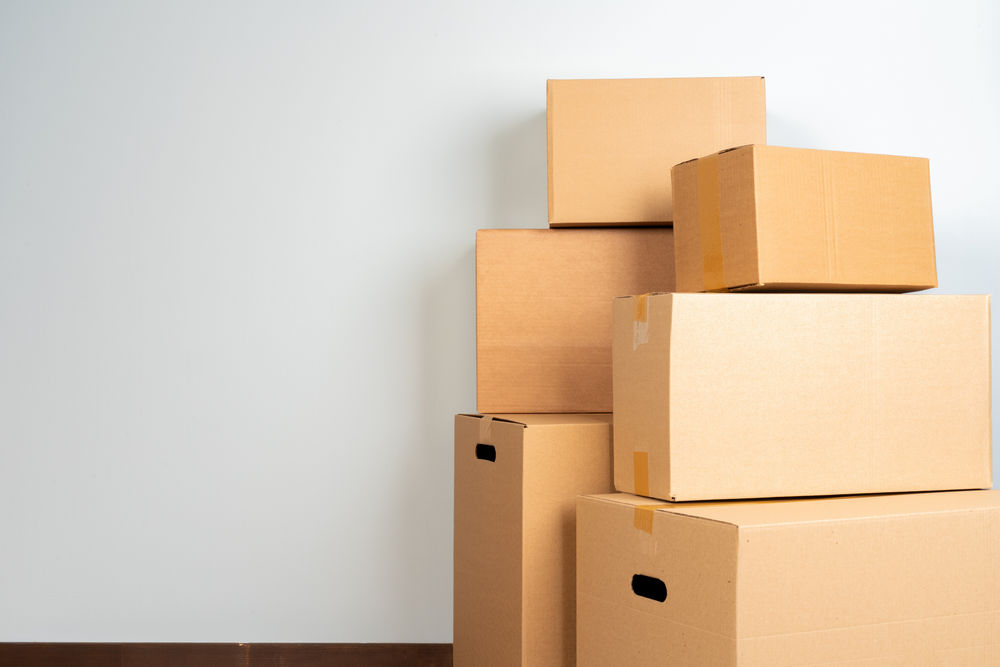Shipping Moving Boxes and the Cheapest Ways to Ship Boxes
I’ve always felt that a well-packed box is like a little time capsule. You tuck away items that carry memories - maybe your favorite coffee mug or that framed family photo you love - and send them off to a new place. Before you know it, the box is waiting to be opened in your next home, ready to unfold a piece of your life all over again.
How much will my move cost?
Let us help match you
Thank you!
Your movers will contact you shortly.

Written by: National Movers Team
NationalMovers team provides expert insights, mover comparisons, and practical resources to help you make informed moving decisions. Whether you need company reviews, relocation tips, or expert guidance, we’ve got you covered. Read more
Reviewed by: Jason Walker
Jason Walker is a moving expert with personal and professional experience, sharing tips, guides, and reviews to make your relocation stress-free. Read more
Last Update: 06/15/2025
Hello, I’m Jason Walker from National Movers, and I’ve spent countless hours – both personally and professionally – researching and testing the best ways to ship moving boxes. My own family relocated a few times while I was growing up, and I remember how each move felt like a fresh start, but also came with its share of logistical headaches.
One of the biggest puzzles folks face is figuring out how to ship boxes without emptying their wallets. Shipping fees can pile up, especially if you’re sending large or heavy boxes across multiple states. There are a handful of carriers and methods, each with its quirks, so it’s easy to feel lost. My sister Megan learned this the hard way after her fifth move in three years, juggling photography equipment and baby gear. She’d sigh and say, “I can’t keep guessing every time.” So we turned the guessing game into a process, comparing services and noting what worked best.
In this article, I’m hoping to share that process with you. We’ll talk about factors to keep in mind when you’re deciding how to ship your moving boxes. Things like size, weight, insurance, or how far you’re sending your items can all make or break your experience. Then we’ll look at the cheapest ways to ship, with short overviews of different providers – from reliable old USPS to lesser-known options like Amtrak Express Shipping.
Best Overall Value Best Overall Value

- Nationwide availability
- Clear pricing, no hidden fees
- Premium door-to-door service
Need Help? Call Now
855-930-4574- Nationwide availability, over 25 years of experience, premium door-to-door service

- Reliable moving & Storage solutions
- Top-quality services, trained staff
- Reliable moving & Storage solutions, top-quality services, trained staff
To top it off, we’ll run through a few cost tables that’ll give you a ballpark figure. I’ll sprinkle in some packing tips, too, because it doesn’t matter how cheap your shipping method is if your fragile dishes end up in pieces. And remember, shipping boxes isn’t just for full-scale house moves – sometimes you only need to send a few small parcels or maybe help a friend who’s shipping a couple of care packages.
By the time you finish reading, I want you feeling ready to box up your life with confidence, whether that’s a simple one-state hop or a cross-country venture. Let’s look at the nitty-gritty so you can choose the carrier and method that suits your situation and your bank account. After all, finding a stress-free way to ship boxes can help you focus on the fun stuff – like turning your new place into a home.
Size and Weight Matter
Heavier or oversized boxes cost more to ship, so consider splitting large loads into several medium boxes.
Distance and Speed Affect Pricing
Longer distances and faster shipping methods increase costs. If you’re flexible on timing, ground shipping can help you save.
Insurance and Tracking Offer Peace of Mind
Most carriers provide tracking, but for pricey or sentimental items, adding insurance can protect you from potential losses.
Cheapest Carriers Vary by Situation
USPS is often great for small or lightweight packages, while UPS or FedEx may be more budget-friendly for bigger, heavier boxes. Amtrak and Greyhound can be surprising money-savers if you’re near their stations.
Proper Packing Prevents Damage
Using sturdy boxes, reinforcing seams, and cushioning fragile items can prevent breakage and keep your shipment intact.
Compare Prices and Services
Spending a few minutes reviewing different shipping calculators (USPS, UPS, FedEx) can reveal substantial cost differences. Don’t overlook alternative solutions like U-Box or PODS if you’re shipping furniture along with boxes.
Organization and Timing Are Key
Start early, label your boxes, and weigh them accurately to avoid surprises on shipping day. A little planning goes a long way toward a smooth move.
Factors to Consider When Shipping Moving Boxes

Before jumping into actual companies, it’s worth understanding a few key factors. If you think about it, shipping boxes isn’t just about slapping on a label and calling it a day. Each decision point – size, weight, distance, insurance – plays a big role in your budget and your peace of mind.
Get matched with the best mover for your needs!
Thank you!
Your movers will contact you shortly.
Cheapest Ways to Ship Boxes
When a friend asks me, “Which carrier should I pick?” I like to respond with, “It depends on what you’re shipping and how fast you need it.” Still, there are a few go-to services that consistently offer cost-effective options. That said, I’ve tested each one while helping family and friends move, so these observations stem from real situations, not just random guesses.
Best Shipping Companies for Moving Boxes
Below is a quick rundown, comparing various shipping services on what they excel at and their approximate cost range. These figures come from my personal experiences, as well as data from National Movers’ comprehensive directory.
Please note that prices are estimates for informational purposes and may vary based on individual factors.
| Shipping Service | Best For | Average Cost Estimate |
| USPS | Small, lightweight, or flat-rate boxes | $10–$45+ per box |
| UPS | Larger, heavier boxes | $20–$60+ per box |
| FedEx | Flexible shipping speed options | $20–$70+ per box |
| Amtrak Express Shipping | Budget shipping via station drop-off | $40–$80+ (varies by route) |
| Greyhound Package Express | Oversized or bulky packages on a budget | $40–$100+ (station-to-station) |
| U-Haul U-Box / PODS | Multiple boxes or entire household | $300–$3,000+ (depends on distance and container size) |
How to Pack Boxes for Safe Shipping

It’s not enough to find a cheap service if your boxes arrive looking like they’ve been through a rock tumbler. I learned this the first time I shipped delicate glassware. Three cups arrived cracked because I hadn’t given them any extra padding. Here’s a straightforward approach:
- Choose Sturdy Boxes
Resist the temptation to recycle that beat-up box from your last online order. Aim for new or gently used boxes that can stand up to a cross-country trek. - Reinforce the Bottom
I swear by the “double-tape” method. Lay two strips of packing tape along the seam, then one strip running perpendicular. It might look like overkill, but it keeps your box’s contents snug. - Use Cushioning Material
Bubble wrap, packing paper, or even old blankets can help absorb shocks. Crumple paper around fragile items and fill empty spaces to keep your belongings from bouncing around. - Label Fragile Items Clearly
It takes only an extra minute to write “Fragile” or “Handle with Care.” You can’t guarantee gentle treatment, but it’s better than leaving the box unmarked. - Distribute Weight Evenly
Don’t pack 100 pounds of books into a single box. Spread them out so you don’t injure yourself – or your shipping courier – and so the box doesn’t burst. - Seal the Top Properly
Tape the top as you would the bottom. Remember that your box might end up at the bottom of a stack, so treat the top with equal care.
Cost Estimates for Shipping Moving Boxes
I’ve compiled a basic comparison chart below to give you a general idea. Keep in mind that rates often fluctuate, so checking a carrier’s official pricing or using their online calculator is always a smart step.
| Box Weight | USPS Retail Ground | UPS Ground | FedEx Home Delivery |
| 10 lbs | $18–$25 | $17–$25 | $18–$26 |
| 30 lbs | $35–$48 | $30–$50 | $32–$52 |
| 50 lbs | $50–$70 | $45–$70 | $46–$75 |
These figures are rough estimates based on actual moves I’ve done and information from National Movers. Your final price can shift depending on where you live and how far your box travels.
Best Way to Ship Boxes When Moving
So, which method is best? It boils down to your priorities. If you’re moving on a tight budget and don’t have a lot of stuff, USPS with its Flat Rate boxes might be the way to go. If you’re dealing with heavier or bigger items and you want reliability, UPS or FedEx are strong contenders. Meanwhile, if you live near a major train or bus station, Amtrak Express Shipping and Greyhound can be surprisingly wallet-friendly for bulky loads – though they require a bit of extra legwork.
When I moved from Austin to Nashville, I had a split strategy: I used FedEx for a handful of heavier boxes that needed a more standard door-to-door approach, and I shipped some smaller, lightweight boxes with USPS. It was a bit of extra planning, but I ended up saving money. Don’t be shy about mixing and matching carriers. Sometimes your best bet is a hybrid solution, especially if you’re comfortable juggling multiple shipments.
Cheapest Ways to Move Boxes Across the Country
Moving across multiple states can feel like crossing a logistical minefield. Luckily, there are a few ways to keep things affordable:
- Compare Carriers
Taking 15 minutes to look at shipping calculators from USPS, UPS, and FedEx can save you a good chunk of change. Rates can vary day by day, or even by time of year, so a quick check helps you snag the best deal. - Use Slower Shipping Speeds
Ground shipping options are usually cheaper. If you can wait a few extra days for your boxes, you can avoid premium fees. - Look for Discounts
Some carriers offer discounted rates if you set up a free online account. UPS and FedEx sometimes run promotions or have membership perks that slightly reduce shipping costs. - Leverage Rail or Bus Services
Amtrak Express Shipping and Greyhound Package Express can be excellent for large or heavy boxes. The biggest trade-off is convenience – be ready for station drop-offs and pickups. - Seek Out Flat Rate Deals
USPS Flat Rate boxes can be a lifesaver if your items are heavy but compact. It’s all about getting the most out of the designated box size.
Shipping Moving Boxes Tips
Let’s pause for a moment and talk about some general advice. Over the years, I’ve noticed a few tips that can make the difference between a seamless shipping experience and a headache:
- Plan Early
Don’t wait until you’re knee-deep in bubble wrap. Give yourself time to find boxes, gather packing materials, and figure out your shipping plan. Rushed decisions often cost more. - Weigh Your Boxes
Many folks guess how heavy a box is, but an actual scale can save you from miscalculating shipping fees. A simple bathroom scale might do the trick. - Keep Track of Tracking
It’s easy to lose track (pun intended) when you’ve got multiple boxes on the move. Write down or save the tracking numbers in your phone or on a piece of paper you won’t misplace. - Bundle Insurance for Pricier Items
Not everything needs to be insured, but if you have collectibles, electronics, or sentimental items, paying for insurance can protect your wallet and your nerves. - Know the Claims Process
Before shipping, check how you’d file a claim if something goes missing or arrives damaged. Some carriers make it straightforward; others – not so much. - Stay Organized
Label each box with a short description of its contents. This helps both you and any family members, roommates, or movers who are helping unload. - Consolidate and Declutter
The fewer boxes you ship, the cheaper it is. Consider donating or selling things you don’t need before you start packing. Trust me, it’s liberating – and cost-effective.
FAQs About Shipping Moving Boxes
What is the cheapest way to ship a box across the country?
It really depends on what you’re shipping and how quickly you need it delivered. For smaller or lightweight boxes, USPS Flat Rate can be surprisingly cost-effective. If you have heavier items, you might look at UPS Ground or FedEx Home Delivery. And if you’re near a bus or train station, services like Greyhound Package Express or Amtrak Express Shipping can offer lower rates – though you have to manage drop-off and pickup at the stations yourself.
Can I ship multiple boxes together?
Yes, you can. If you’re using a service like UPS or FedEx, you’ll simply create separate labels for each box. For methods like Greyhound or Amtrak, you’d drop off each box at the station and fill out the corresponding paperwork. If you’re considering shipping lots of boxes or even furniture, container services such as U-Box or PODS might be a better deal, since you can load everything in one place without juggling multiple shipments.
How can I track my shipment?
Most major carriers (USPS, UPS, FedEx) provide tracking automatically. You’ll receive a tracking number when you purchase your label, which you can use on the carrier’s website or mobile app. With Amtrak and Greyhound, you typically get a waybill or reference number to see where your package is – though sometimes the updates might be less frequent than with standard parcel services.
What’s the best way to ship fragile items?
Bubble wrap is your friend, along with sturdy boxes. Make sure each breakable item is cushioned on all sides. Fill empty spaces with packing peanuts or crumpled paper so nothing shifts in transit. Mark the box “Fragile” in big letters. If it’s something really valuable or sentimental, consider adding insurance for peace of mind.
Does the box have to be brown?
Not necessarily. While many of us are used to plain brown boxes, carriers don’t mind if you use a different color or re-brand them – so long as the box is sturdy and the shipping label is clear. Just be cautious with any bright, distracting prints that might make your label hard to read or scan.
Can I ship previously used boxes?
Absolutely. I do it all the time – as long as the box is still structurally sound. Double-check for any tears, weak spots, or old barcodes. If you spot an old shipping label, peel it off or cover it up with a fresh one. A used box in good shape can save money and help the environment at the same time.